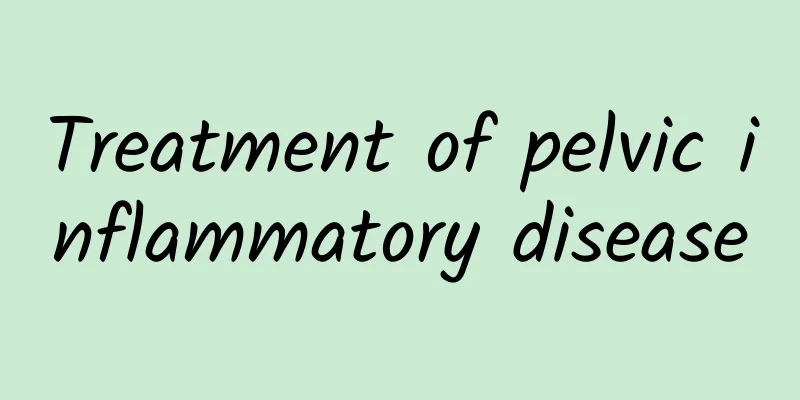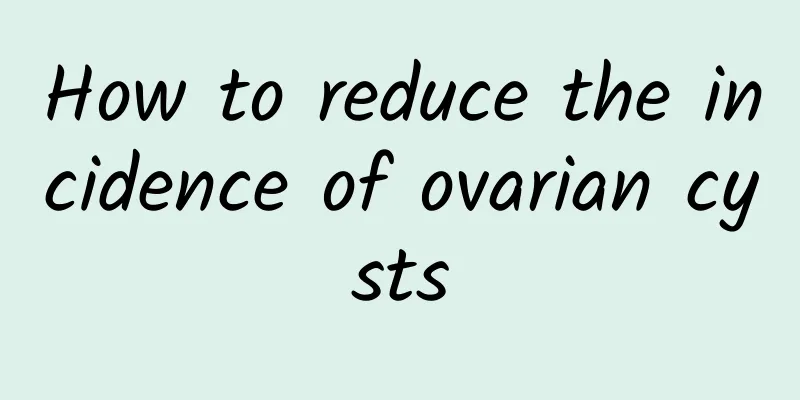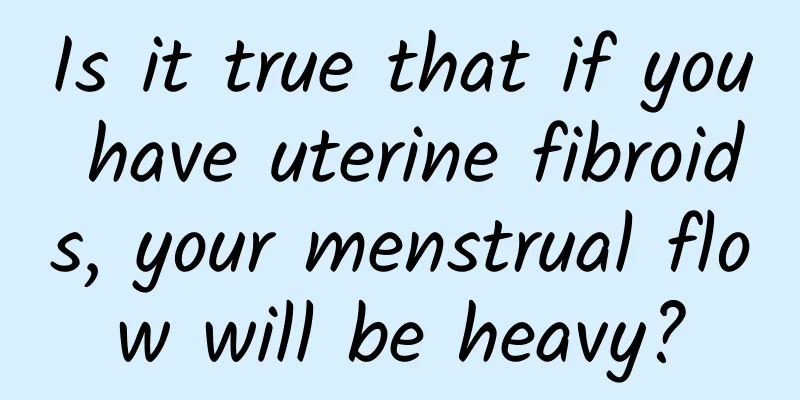Treatment of pelvic inflammatory disease

|
Pelvic inflammatory disease can be said to be a common inflammation of the female reproductive organs. Pelvic inflammatory disease can cause lower abdominal distension, pain, etc. Nowadays, there are many treatments for pelvic inflammatory disease. Let's take a look at them together. Types of treatment for pelvic inflammatory disease 1. Psychotherapy General treatment relieves patients' mental concerns, enhances their confidence in treatment, increases nutrition, exercises the body, pays attention to the combination of work and rest, and improves the body's resistance. 2. Traditional Chinese medicine treatment Chronic pelvic inflammatory disease is mostly of damp-heat type, and the treatment principle is to clear away heat and dampness. The main treatment is to promote blood circulation and remove blood stasis. The prescription is: Danshen 18g, red peony root 15g, costus root 12g, peach kernel 9g, honeysuckle 30g, dandelion 30g, Poria 12g, moutan bark 9g, and raw earth 9g. When the pain is severe, add Yanhusuo 9g. Some patients are of cold stagnation and qi stagnation type, and the treatment principle is to warm the meridians and dispel cold, promote qi and activate blood circulation. Guizhi Fuling Decoction is often used with modifications. For those with qi deficiency, add Codonopsis pilosula 15g, Atractylodes macrocephala 9g, and Astragalus 15g. 3. Physical therapy The benign stimulation of warmth can promote local blood circulation in the pelvic cavity, improve the nutritional status of tissues, and increase metabolism, so as to facilitate the absorption and disappearance of inflammation. Commonly used methods include short wave, ultrashort wave, ion penetration (various drugs such as penicillin, streptomycin, etc. can be added), wax therapy, etc. 4. Other drug treatments Because the female reproductive system has a natural defense function, under normal circumstances, it can resist the invasion of bacteria. Only when the body's resistance is reduced or the female's natural defense function is damaged due to other reasons, will pelvic inflammatory disease occur. The more professional treatment for pelvic inflammatory disease is Gong Shu Mi Qing, which can completely help cure pelvic inflammatory disease. 5. Surgical treatment Surgery is recommended for lumps such as hydrosalpinx or tubo-ovarian cysts. Surgery is also recommended for those with small infection foci that repeatedly cause inflammation. The principle of surgery is to completely cure the disease and avoid the chance of recurrence of residual lesions. Unilateral adnexectomy or hysterectomy plus bilateral adnexectomy is performed. Ovarian function should be preserved as much as possible for young women. Single therapy for chronic pelvic inflammatory disease is less effective, so comprehensive treatment is appropriate. 6. Traditional Chinese Medicine Treatment Inflammatory bowel disease is a common gynecological disease, which is the abbreviation of inflammation of the female pelvic reproductive organs, including metritis, pelvic peritonitis, pelvic gland inflammation and salpingo-oophoritis. And Chinese medicine also has a trick to treat pelvic inflammatory disease. Traditional Chinese medicine divides pelvic inflammatory disease into five categories. By combining syndrome differentiation and treatment with Western medicine, it can achieve the effect of treating both the symptoms and the root cause. 1. Heat toxicity type: high fever, chills, headache, lower abdominal pain, vaginal discharge with a large amount of pus and foul odor, yellow urine and constipation, red tongue, yellow tongue coating, slippery and rapid or stringy pulse. 2. Damp-heat type: low fever, burning pain in the lower abdomen, dry mouth and no desire to drink, vaginal discharge of large amount and thick yellow color, or a mixture of red and yellow, red tongue with yellow and greasy coating, and slippery and rapid pulse. 3. Damp-heat stasis type: abdominal distension and pain, bitter and dry mouth, yellow and thick vaginal discharge, turbid urine, dry and hard stools, dark red tongue, yellow or white tongue coating, and stringy or rapid pulse. 4. Blood stasis type: persistent pain in the lower abdomen that refuses to be pressed, or irregular menstruation, or heavy menstrual flow with clots, dark purple tongue, or with ecchymosis, thin tongue coating, and deep, stringy or astringent pulse. 5. Chong and Ren deficiency cold type: cold pain in the lower abdomen, likes warmth and pressure, more vaginal discharge with thin white content, fear of cold and cold limbs, pale tongue, thin white fur, deep and fine pulse. Commonly used Chinese patent medicine oral pills Fuyan Pills have the effects of clearing heat and detoxifying, promoting blood circulation and removing blood stasis, and can be used in combination. Any disease in the female reproductive system may cause pelvic inflammatory disease, which can be serious or minor, and can easily lead to infertility, so it must be treated. Pelvic effusion is the presence of inflammatory exudate in the pelvic cavity. It can occur after the endometrium becomes inflamed, and the slightly viscous fluid exudates from the swollen cells of the endometrial tissue, which is gradually formed into a cystic mass when it is wrapped by the surrounding tissue. 2. Treatment of pelvic inflammatory disease 1. Medication Acute pelvic inflammatory disease or acute attack of chronic pelvic inflammatory disease should be treated with antibiotics. Chronic pelvic inflammatory disease can be treated with traditional Chinese medicine more thoroughly, but it takes a long time. Fuqing Pills can regulate the endocrine system by strengthening the body's constitution, ultimately achieving the effect of regulating menstruation and curing the root cause. 2. Physical therapy The physical therapies that have good effects are mainly microwave and extracorporeal shortwave, both of which are non-invasive and non-invasive treatments. 3. Surgery Most of the patients who choose surgery are infertile patients. When pelvic inflammatory disease is so severe that the fallopian tubes are blocked, then surgical treatment of pelvic inflammatory disease is the fastest and most effective treatment method. The three-dimensional five-cavity comprehensive therapy uses a new generation of multifunctional interventional microwaves, a high-tech device, for instrumental treatment. It uses a single 915±13mHZ light wave to kill bacteria in deep inflammatory sites, and the treatment is non-invasive and painless. This therapy can enhance the metabolic function of the lesion site, promote blood circulation, increase the permeability of capillaries, and facilitate the absorption of drugs; the five-cavity catheter intervention directly delivers special Chinese and Western medicines to the lesion site, accelerates the elimination of inflammatory metabolic waste, and can quickly eliminate inflammation; combined with a series of selected Chinese and Western medicines for oral administration, it promotes blood circulation in organs, improves the supply of nutrients to the mechanism, promotes cell regeneration, loosens adhesions and repairs tissues. After a large number of clinical verifications, the three-dimensional five-cavity therapy is very effective in treating gynecological pelvic inflammatory disease, and has brought good news to thousands of patients with pelvic inflammatory disease who have been unable to be cured for a long time. 3. Folk remedies Bitter Vegetable and Radish Soup Ingredients: 100g bitter herbs, 20g honeysuckle, 25g dandelion, 200g green radish (sliced. Usage: decoct the above four ingredients together, remove the herbs and eat the radish and drink the soup. Take 1 dose per day. Effect: Clearing away heat and detoxifying Indications: Pelvic inflammatory disease of the damp-heat and blood stasis type, with fever, distension and pain in the lower abdomen, pain on both sides of the lower abdomen that refuses to be pressed, yellow and profuse vaginal discharge, red tongue with yellow fur, and slippery and rapid pulse. Note: Honeysuckle has varying degrees of inhibitory effects on a variety of bacteria such as Staphylococcus, Streptococcus, Pneumococcus, Escherichia coli, Pseudomonas aeruginosa, and skin fungi. 4. Diet therapy Silver Flower Winter Melon Kernel Honey Soup Ingredients: 20 grams of wax gourd seeds, 20 grams of honeysuckle, 2 grams of coptis chinensis, and 50 grams of honey. Usage: First fry honeysuckle, remove the residue and take the juice, fry wax gourd seeds with the juice for 15 minutes, then add coptis root and honey. Take 1 dose daily for 1 week. Efficacy: Clears away heat and detoxifies. Indications: Pelvic inflammatory disease, of the damp-heat and blood stasis type, pain in the lower abdomen and both sides of the lower abdomen, refusal to press, slight fever, spontaneous sweating, yellow vaginal discharge, red tongue with yellow fur Peach Cookies Ingredients: 20 grams of peach kernels, 200 grams of flour, 30 grams of sesame oil. Usage: Grind peach kernels into very fine powder and mix thoroughly with flour, add 100 ml of boiling water, knead thoroughly, cool, roll into a thin rectangular skin, apply sesame oil, roll into a cylinder, cut into 30g pieces with a knife, roll into round cakes, and bake on a pan. Take it at will for breakfast and dinner, several times a day, 2 pieces each time, with warm water. Efficacy: Regulates qi and activates blood circulation, dissipates blood stasis and relieves pain. Indications: Pelvic inflammatory disease, of the Qi stagnation and blood stasis type, pain in the lower abdomen and both sides of the lower abdomen like needle pricks, pain in the lumbar spine, purple tongue, and thin and stringy pulse. Saffron tea Ingredients: 10 grams of green peel and 10 grams of safflower. Usage: Dry the green peel and cut it into shreds, put it into a casserole with safflower, add water and soak for 30 minutes, boil for 30 minutes, filter with clean gauze, remove the residue, and take the juice. Drink it frequently as tea, or take it twice a day in the morning and evening. Efficacy: Regulating qi and activating blood circulation. Indications: Pelvic inflammatory disease, of the Qi stagnation and blood stasis type, pain in the lower abdomen and both sides of the lower abdomen like needle pricks, soreness in the waist and sacral region, purple tongue, and stringy pulse. Lychee honey drink Ingredients: 30 grams of litchi kernels, 20 grams of honey. Usage: Crush the lychee kernels and put them into a casserole. Soak them in water for a while. Boil for 30 minutes. Remove the residue and take the juice. Add honey while it is still warm and mix well. Take twice a day, morning and evening. Efficacy: Regulating Qi, promoting diuresis and relieving pain. Indications: various types of chronic pelvic inflammatory disease, pain in the lower abdomen and both sides of the lower abdomen, discomfort, depression, and excessive vaginal discharge. 1. Apply garlic paste to the lower abdomen 1 to 2 times a day (stop if blisters occur on the skin). 2. Mix 120 grams of gansui powder, 0.1 gram of musk, together with fine flour and honey to make a paste. Divide it into 4 portions and apply 1 portion per day to the lower abdomen. 3. Mash 250 grams of fresh dandelion into a paste and apply it to the lower abdomen 1 to 2 times a day. 4. Boil 30 grams of soapberry thorns and 10 jujubes together for more than half an hour, discard the residue and take 300-400 ml of the medicinal liquid, add 30 grams of polished rice and cook into porridge, take it in two doses. 5. Melt the paraffin and put it into two rubber bags of 28x21 cm, or put the paraffin into the bag and melt it again. The wax liquid occupies about 1/3 of the bag volume. The temperature is about 60℃~70℃. Place it on the patient's lower abdomen or lumbar sacral area. Each treatment lasts 30 minutes. 15 times is a course of treatment. 5. Family therapy 1. Pay attention to personal hygiene Strengthen personal hygiene during menstruation, after childbirth, and after miscarriage, change underwear and sanitary napkins frequently, avoid colds, and avoid overwork. 2. Eat more light food The diet should be light. Eat more nutritious foods such as eggs, tofu, red beans, spinach, etc. Avoid eating raw, cold and irritating foods. 3. Avoid sexual intercourse during menstruation Avoid sexual intercourse during menstruation to avoid infection. Menstrual pads should be kept clean and hygienic, and it is best to use sterilized toilet paper. 4. Drink water Pelvic inflammatory disease can easily cause fever, so be sure to drink plenty of water to lower your body temperature. 5. Avoid unnecessary gynecological examinations Try to avoid unnecessary gynecological examinations to prevent the infection from spreading and the inflammation from spreading. 6. Medical staff must strictly follow aseptic operation Medical staff should strictly disinfect and strictly follow aseptic operation procedures during delivery and abortion uterine cavity surgery to avoid infection and pelvic inflammatory disease. For prevention, antibiotics should be taken appropriately after surgery to prevent infection. Pelvic inflammatory disease topic: http://www..com.cn/fuke/pqy/ |
<<: Can I get pregnant if I have uterine adnexitis?
>>: Experts tell you what are the causes of ectopic pregnancy?
Recommend
How to review recurrent miscarriage in early pregnancy and what needs to be done?
Women with recurrent miscarriage must have regula...
In summer, we should do a good job in preventing pelvic inflammatory disease
Hot and humid weather is a period when bacteria m...
What are the causes of primary uterine fibroids? Oral contraceptives can also cause uterine fibroids
What is the cause of primary uterine fibroids? Th...
What are the treatments for female cervical hypertrophy?
Many people want to know the methods of treating ...
What are the symptoms of uterine fibroids?
Uterine fibroids are the most common gynecologica...
What are the symptoms of uterine fibroids? Is increased vaginal discharge a manifestation of uterine fibroids?
There are also many symptoms of uterine fibroids....
What's wrong with burping and bloating during menstruation?
What’s wrong with hiccups and bloating during men...
Eat pasta without worries! Nutritionists teach you 3 secrets to not getting fat
Whether it is a weekday dinner, a gathering with ...
Symptoms of ectopic pregnancy include abdominal pain in the early stages
The symptoms of ectopic pregnancy include abdomin...
What are the common causes of cervical erosion in women? Top ten causes of cervical erosion
Cervical erosion is a disease that many female fr...
The cause of acute cervicitis is related to viral infection
Acute cervicitis is mainly caused by bacteria dir...
Experts briefly analyze the common symptoms of uterine fibroids
Some of the symptoms of uterine fibroids are rela...
A brief discussion on how to prevent vaginitis among white-collar women
Vaginitis is a common gynecological inflammation,...
Causes of dysmenorrhea in women
Dysmenorrhea is something that many women will en...
Increased vaginal discharge should be alert to the symptoms of cervicitis in women
Usually, the symptoms of female cervicitis are ba...









